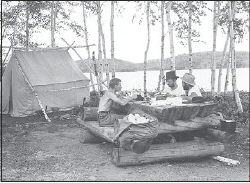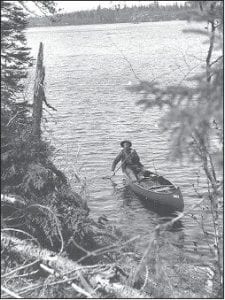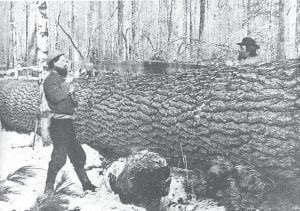The Superior National Forest turned 100 this year. On February 13, 1909, Theodore Roosevelt, wanting to leave a final legacy after two terms in office, set aside 644,114 acres of land in northeast Minnesota, much of it burned-over or cut-over and considered by some to be land that nobody else wanted. Now the area is almost four times its original size and is considered by some to be the best place in the world.
With 20% of its surface covered by water, the Superior National Forest (SNF) contains more than 2,000 lakes. It is crossed by the Superior Hiking Trail, touted by Forest Service spokesperson Kris Reichenbach as one of the top ten hiking destinations in the United States. According to Reichenbach, the National Geographic Society has rated the forest’s Boundary Waters Canoe Area Wilderness (BWCAW) one of the 50 greatest places to visit – in the world.
The northeast corner of Minnesota has a long history of its own, of course, prior to the existence of the Superior National Forest. Volcanoes laid its bedrock, and ancient sea algae created conditions that led to deposits of iron ore throughout the region. TheLaurentian Mountain Range grew and shrank, and climates changed. Glaciers scraped away sandstone, exposing the bedrock again. The forest once contained primarily oak before a cooler climate brought pine, eventually joined by cedar, maple, birch, and poplar, among others.

Above: Three campers eating lunch at a canoe campsite on Birch Point on the south arm of Knife Lake in 1940.
Native Americans, who lived lightly on the land, were here for many years before furtrading voyageurs and European settlers joined them. Through the Superior National Forest Heritage Program, born in 1979, more than 3,000 heritage sites – almost evenly divided between historic and prehistoric – have been located and recorded.
According to Gunflint and Tofte Ranger District Interpreter Steve Robertsen, part of President Roosevelt’s plan was to use national forests for multiple purposes, including recreation, research, and sustainable harvesting of natural resources.

Left: Superior National Forest Guard Soderback on Clear Lake during a survey in 1921 with Forest Landscape Architect Arthur Carhart.
Mining exploration was in full swing in northeast Minnesota by the 1870s. Investors had high hopes for the Paulson Mine on the Gunflint Trail and the adjacent Port Arthur, Duluth, and Western (PADW) Railroad that would deliver minerals to regional transportation centers. A financial panic in 1893 left the Paulson Mine without financing, and the PADW ended up closing in 1914 after hauling only one load of iron ore.
Railroads also provided greater access to northeast Minnesota timber stands, resulting in the harvest of large tracts of white pine. Robertsen, in a 2009 article on SNF history for Wolf Ridge Environmental Learning Center, said that in 1901, enough wood was harvested from Minnesota forests to build 600,000 twostory homes or build a nine-foot boardwalk around the earth.
How nice was this area around the turn of the century? Joe Fitzwater, SNF’s first supervisor, wrote, “It was a wonderful backwoods country with nobody back in there. Most of it had been logged and burned over. It was mostly jack pine with very little white pine, and a few shrubs here and there.”
Three years earlier, surveyor Wes White did not use the word “wonderful” as he wrote in his journal about the area: “In winter there is about four feet of snow to contend with and in the summer the flies and mosquitoes drive even the thick-skinned moose into the lake and ponds and will not allow a man to sleep at nights.
“…In summing up the entire contract I may truly say it lies in the most forsaken country it has ever been my misfortune to encounter. There is apparently nothing within the boundaries of the four townships that would induce a sane person to enter within the unsacred domain of moose, wolves, bears, snow, rain, mosquitoes, flies, rocks, swamps, brush and rapids.”
One goal of early forest management focused on fire prevention, especially after huge fires out West and the deadly Hinkley fire.
As part of the federal government’s effort to reduce the effects of the Depression in the 1930s, 30 Civilian Conservation Corps (CCC) camps left a legacy of pine plantations, solid log ranger buildings, and miles of forest trails. Robertsen said typical CCC workers gained weight during their first year since they were fed better at camp than their families had been able to feed them at home.
During World War II, iron ore from the Superior National Forest was used in the machinery that helped the Allies win.
The Baby Boom brought about a building boom resulting in the doubling of timberrelated jobs in Minnesota, and the prosperity of the 1950s brought about the popularity of the family car vacation, bring the SNF into prominence as a family vacation destination.
Since its official inception in 1905, the United States Forest Service has had to contend with sharp controversies over the use of its publicly owned natural areas. While tourism became an industry, environmentalism became a movement, Robertsen wrote. Multiple use of the forest brought about multiple conflicts.
What would become known in 1958 as the Boundary Waters Canoe Area (BWCA) was designated a roadless area in 1926. In 1948, the Thye-Blatnik Act authorized the federal government to acquire private land holdings within roadless areas, leading to a buy-out of some long-time resort businesses in the forest. A 1949 Executive Order established an airspace boundary over the BWCA, ending the era of fly-in resort vacations.
The 1964 Wilderness Act allowed some logging and use of motors within the BWCA, but the passage of the Boundary Waters Canoe Area Wilderness Act in 1978 eliminated logging and snowmobiling, restricted mining, and left only one fourth of the area open to motorboats.
The United States Forest Service (USFS) mission is to “sustain the health, diversity, and productivity of the nation’s forests and grasslands to meet the needs of present and future generations….” The purpose the first USFS chief, Gifford Pinchot, intended for it remains in the mission statement to this day: “…To provide the greatest amount of good for the greatest amount of people in the long run.”
Forests cover about one third of the United States, providing habitat for wildlife, cleansing air and water supplies, providing harvests of timber and other natural resources, and offering recreational opportunities for all Americans. Forty-four percent of America’s land is in public hands. The 193 million acres of USFS land comprise about nine percent of the total land area in the United States.
Present-day USFS efforts include a multiple use approach that includes sustaining healthy ecosystems while addressing the need for natural resources and wilderness services; long-term scientific research; public education; cooperative programs within the U.S. and abroad; control of destructive insect populations and invasive species; wildfire management; preservation of clean drinking water; cleaning up damages to the environment; and providing alternatives to fossil fuel energy, such as biomass, which according to the USFS could supply up to 15 percent of the nation’s energy.
One of the U.S. Forest Service’s five program areas is the National Forest System, with a mission “to protect and manage the 155 national forests and 20 national grasslands so they best demonstrate the sustainable multipleuse management concept, using an ecological approach, to meet the diverse needs of people.”
According to a 2009 USFS overview “developed to orient the new Administration to the U.S. Forest Service, who we are, what we do, and what we might be in the future,” current goals include continued management amidst an expanding population; controlling an increasing frequency of severe wildland fires and insect and disease outbreaks; sustainably using natural resources “to help meet the demands and needs of a growing America”; conserving open space; enhancing outdoor recreation opportunities; engaging urban America; and providing science-based tools and applications for sustainable management of natural resources.
The Forest Service’s vision for the future includes involvement with climate change, maintaining water quality and supply, using wood for energy, bringing more kids into the woods, recreational use and access for all, stewardship in urban areas, building markets for ecosystem services, expanding “green” jobs in the woods and in the fields of renewable energy and energy efficiency, and international environmental diplomacy.
“Over the past century,” the USFS overview states, “the Forest Service has achieved a balance between providing land stewardship services and meeting public demands for various uses of the national forests. …Sustainable management of these resources ensures that the availability of goods and services is achieved and land productivity is maintained. …The natural resources on these lands are some of the nation’s greatest assets and have major economic, environmental, and social significance for all Americans.”
A Superior National Forest 100th anniversary open house will be held from 1:00 to 4:00 p.m. Friday, June 19 at the Gunflint Ranger District office at 2020 West Highway 61 in Grand Marais.
Happy Birthday, Superior National Forest!
Information for this article was derived from material provided by District Interpreter Steve Robertsen, spokesperson Kris Reichenbach, and the USFS and Superior National Forest websites.



Loading Comments